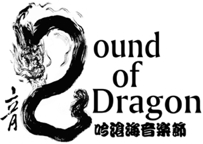click here for: THE LIVING WORLD【生生不息】
2025年4月12日星期六晚上8點
8pm Saturday April 12, 2025 at the Annex, Vancouver
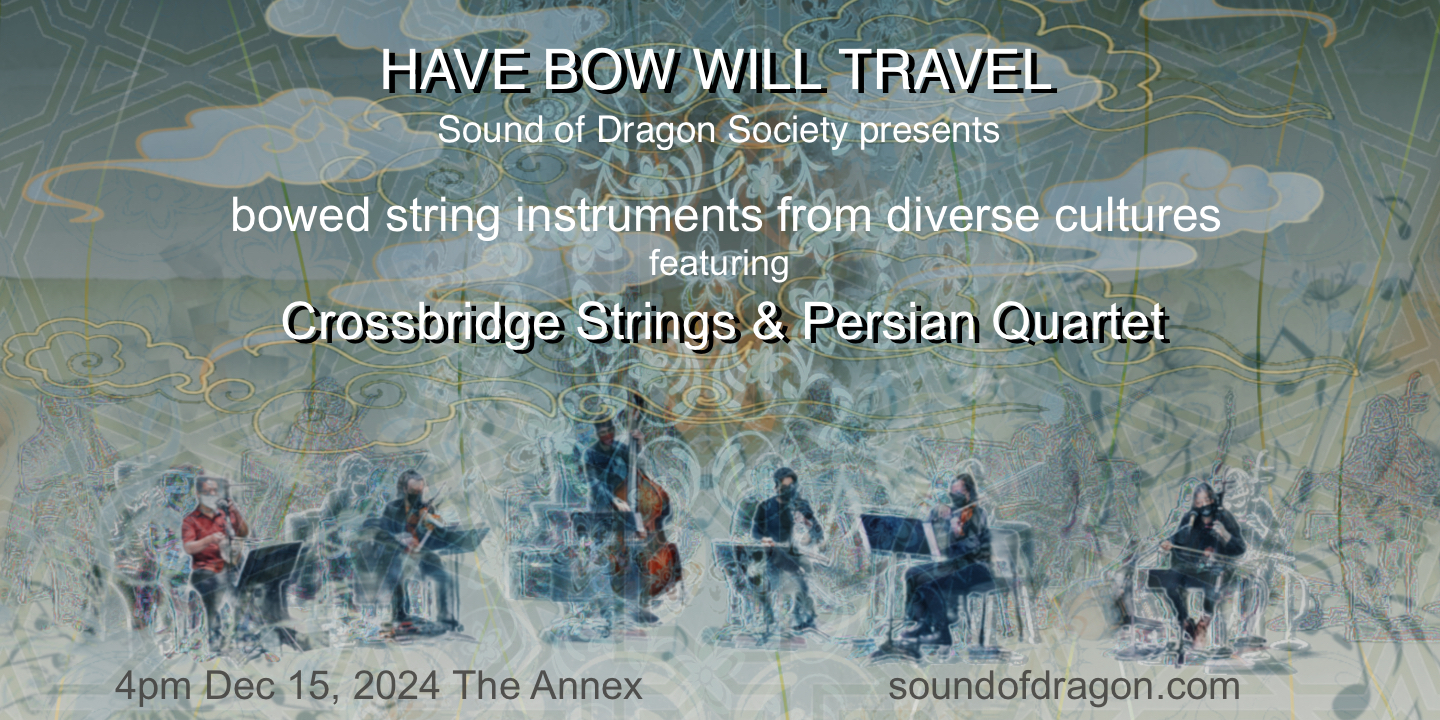
HAVE BOW WILL TRAVEL【多元文化弓弦樂巡禮】中文介紹
4pm Dec 15, 2024 at the Annex,
823 Seymour Street, Vancouver
Co-presentation of Sound of Dragon Society and Crossbridge Strings
BUY TICKETS $19.99 regular (Early Bird $15 by Dec 8),
$15 students/seniors/children
Free for children under 12 years old
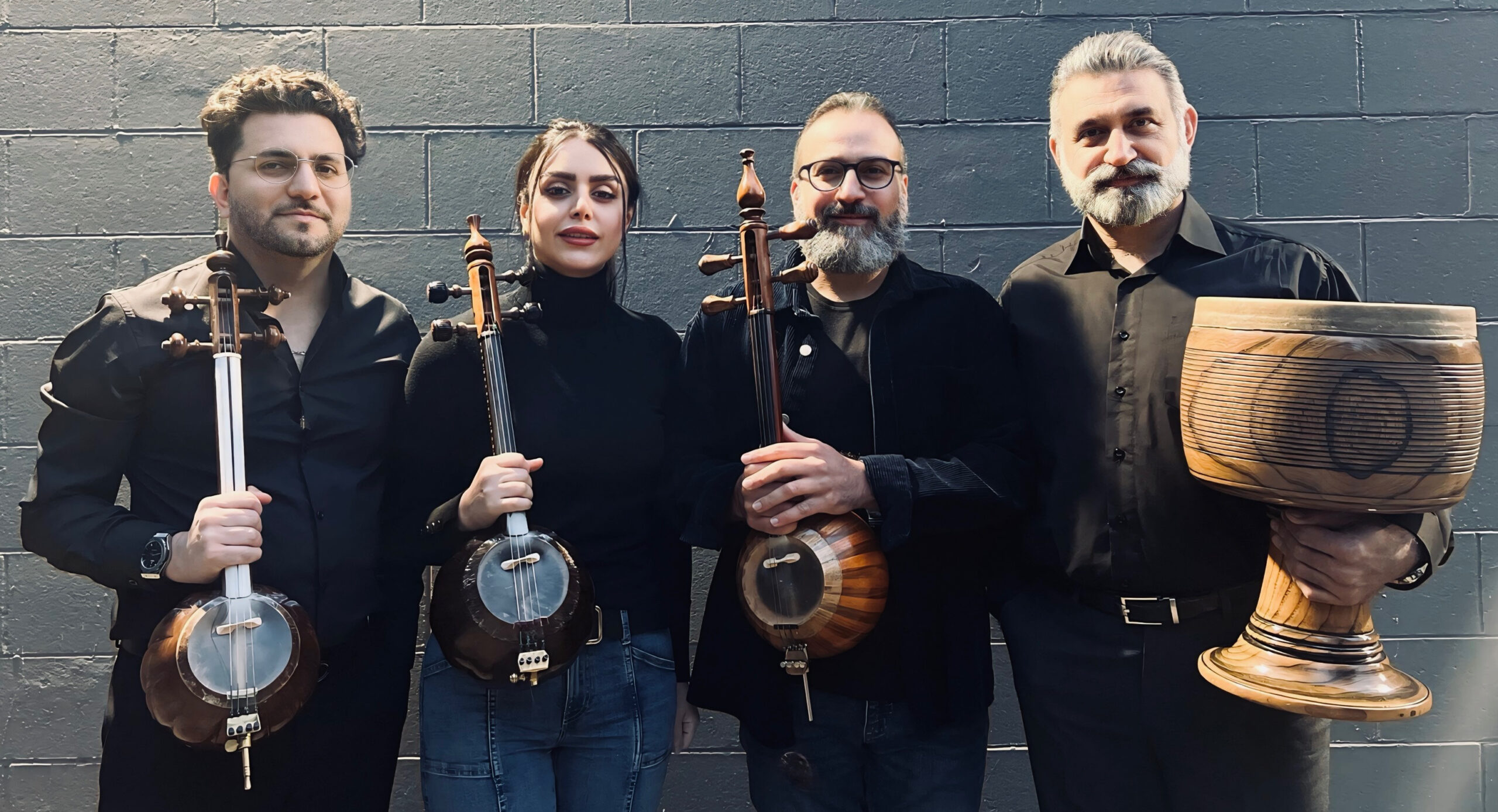
Persian Quartet:
Sina Ettehad, Marjan Alekhamis, Mohammad Amini – kamancheh & kamancheh alto
Babak Banihoseini – percussion
World Premiere:
“Concerto Etude” – Tim Brady composer, for erhu and fixed media
Crossbridge Strings:
Lan Tung – erhu (Chinese fiddle) & vocal
Sutrisno Hartana – rebab & suling (Indonesian fiddle & flute), vocal
Sina Ettehad– kamancheh (Iranian fiddle)
Meredith Bates & Joshua Zubot – violin
James Meger – bass
HAVE BOW WILL TRAVEL showcases bowed string instruments from diverse cultures, including erhu (China), kamancheh (Iran), rebab (Indonesia), violin, and double bass. Various combinations of instruments create dynamic fusions from classical and folk Persian repertoire, to contemporary electroacoustic composition, and improvised music of different approaches.
Sina Ettehad, Marjan Alekhamis, and Mohammad Amini will perform on Persian fiddles: kamancheh and kamancheh alto. Babak Banihoseini joins them on various traditional Iranian drums. This newly formed quartet will perform Iranian classical music, both compositions and improvisation, from the traditional Dastgahi repertoire, rooted in Iranian folk traditions.
Lan Tung will give the world premiere of Montreal composer Tim Brady‘s electroacoustic work “Concerto Etude” for solo erhu (Chinese violin) and fixed media. Brady’s rhythmic, energetic, and colourful work will satisfy the contemporary ears in the audience. Lan recorded this piece for video release during the pandemic. This will be the first time she performs it in front of a live audience.
Established in 2021, Crossbridge Strings brings together Vancouver’s diverse bowed string players from east and west and uses improvisation as the medium for musical exchange. It is a collective of all-star improvising musicians from Iranian, Taiwanese, Indonesian, avant-garde, jazz, and western contemporary music backgrounds: Meredith Bates (violin), Joshua Zubot (violin), James Meger (bass), Sina Ettehad (kamancheh), Lan Tung (erhu & vocals), and Sutrisno Hartana (rebab, suling, vocals). While the strings weave together vibrant tapestries, Sutrisno Hartana and Lan Tung add rich colours and nuances with their unique vocals, and bass and Indonesian drums provide a rhythmic foundation. The sounds from various genres naturally emerge and evolve, revealing distinct characters of each instrument/player and bringing them to the foreground through spontaneous orchestration and dynamic shifts. Traditional and contemporary sounds meet to create unexpected textures that transcend cultural/genre boundaries.
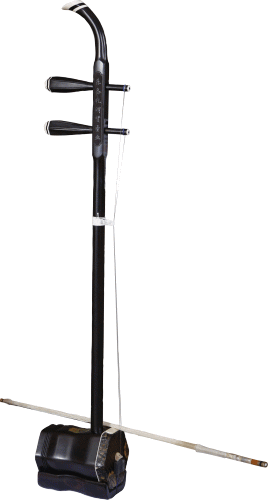
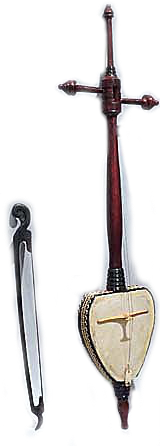
Erhu (Chinese) 二胡
Originated in Central Asia and introduced to China more than one thousand years ago, the erhu 二胡 belongs to the large family of stick fiddles that are found in many countries. Xiqin 奚琴 was the first bowed instrument mentioned in Chinese literature in Tang Dynasty (618-907 A.D.). It is believed to be the precursor of the erhu. Xiqin was also called huqin 胡琴. The erhu is usually made of ebony, sandalwood or rosewood, with a snakeskin resonator. The folk versions vary in the shapes and materials of the sound boxes. The bow is made of bamboo stick and horse hair. Since 1960s, the strings are made of steel, learning from the violin and replacing the silk strings from the ancient time. A popular instrument in solo and ensemble music, erhu’s expressive sound resembles the human voice. Its traditional repertoire is deeply rooted in the vocal and opera traditions.
Kamancheh (Persian)
The kamancheh (or kamanche) has a long neck including fingerboard. The bowl-shaped resonating chamber is made from a gourd or wood, usually covered with a membrane made from the skin of a lamb, goat or sometimes a fish, on which the bridge is set. The kamancheh used to have three silk strings, but the modern instruments have four metal strings. It is widely used in the classical music of Iran, Armenia, Azerbaijan, Kurdistan, Uzbekistan and Turkmenistan with slight variations in the structure.
“kamancheh” = “little bow” in Persian (kæman, bow, and -cheh, diminutive)
Rebab (Arabic: ربابة, rabāba, variously spelled rebap, rubob, rebeb, rababa, rabeba, robab, rubab, rebob, etc) is the name of several related bowed (but sometimes plucked) string instruments that independently spread via Islamic trading routes over much of North Africa, Southeast Asia, the Middle East, and parts of Europe. It is one of the earliest known bowed instruments, named no later than the 8th century, and is the parent of many bowed and stringed instruments.
The Indonesian rebab is a two-string bowed instrument with a wooden body, traditionally made with a single coconut shell. The strings are tuned a fifth apart, and the horse hair bow is tied loosely (unlike modern Western stringed instruments) with the proper tension controlled by the players. In gamelan music, the rebab does not have to conform exactly to the scale of the other instruments and can be played in relatively free time, finishing its phrases after the beat of the gong ageng (the big gong that “rules” the ensemble).

hu = people lived in the north and west of China;
qin = musical instrument
huqin = musical instrument of the hu people, referring to the origin of the instrument
er = two, stating that the instrument has two strings



